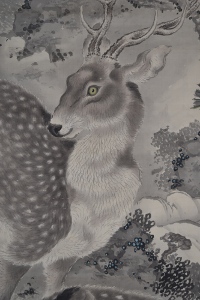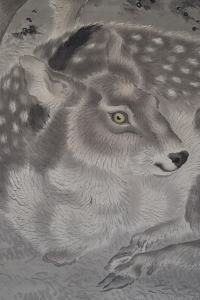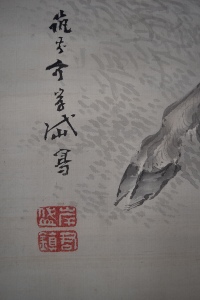/category/highlights/page/3/
Tsukioka YOSHITOSHI (1839-1892)
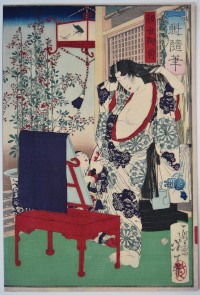
Click here to view image full size.
The great beauty Lady Kaoyo (Gozen) admires herself in a long morror. Lord Ko Moronao, the chief retainer of Shogun Ashikaga Takauji, hears of her beauty and connives to spy on her after her bath. He falls in love, but she is married to En’ya Hankan Takasada. The evil Moronao plots against En’ya although the outcome is that the family is put to death, including En’ya’s wife. The story forms the basis of the famous Chushingura tale. From the set Ikkai zuihitsu, “Essays by Yoshitoshi.” (Ikkai was an early name of Yoshitoshi’s.) A set of thirteen prints published by Masadaya Heikichi 1872/3. A fine set.
Extremely fine impression and colour from the first edition. Most designs from the set have red seals in the margin and red seals over the signature. These were removed on later editions. Trimmed on black border at left, otherwise fine condition. Signed Ikkaisai Yoshitoshi hitsu.
Status: Available
Utagawa HIROSHIGE (1797-1858)
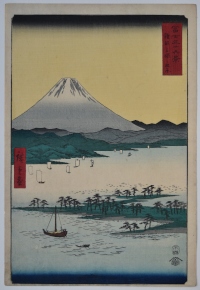
Click here to view image full size.
Suruga, Miho no Matsubara, “Pine Beach of Miho in Suruga [Province]” from Fuji sanjurokkei, “Thirty-six Views of Fuji” published by Tsutaya Kichizo, 1858. A striking design with the yellow sky and one of the best prints from the set. The Miho peninsula has a seven-kilometre seashore lined with pine trees.
Fine early impression and colour with the red signature and title labels double-printed to give a more saturated colour. Fine condition. Signed Hiroshige ga.
Status: Available
Utagawa HIROSHIGE (1797-1858)
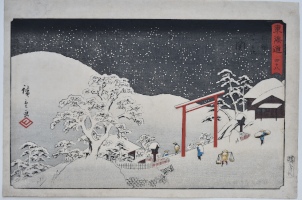
Click here to view image full size.
Seki from a Tokaido set published by Maruya Seijiro, 1850-51, hence it is often referred to as the Marusei Tokaido. Also known as the Reisho Tokaido because the title “Tokaido” is written in formal script. Below is the station number 48. Seki was located where the two highways of Tokaido and Ise-ji meet. Seki means “barrier checkpoint.” Figures pass beneath a torii gate on a snowy hillside.
Fine impression and colour. Minor edge soil, otherwise very good condition. Signed Hiroshige ga.
Status: Available
Kishi GANTAI (1782-1865)
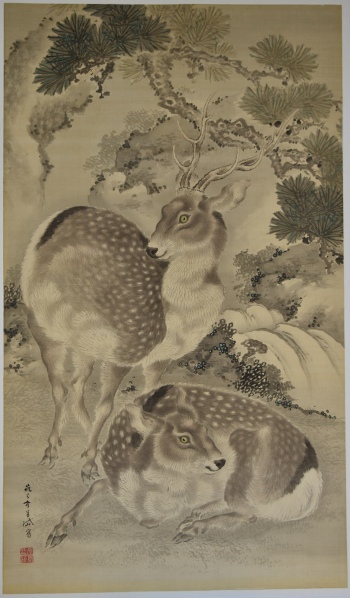
Click here to view image full size.
An extremely large painting, 55.5 x 32 in; 141 x 81.3 cms, sumi and light colour on silk. Shows a pair of Sika deer, their summer coats spotted and white. Gantai was the son and pupil of Ganku, and together with his brother, Renzan, carried on the Kishi school tradition. With his father, worked on the paintings for the new Kanazawa Castle in 1809. A highly accomplished painter, especially of kachoga. This is possibly the largest Gantai painting and it’s interesting to compare with the gajo by him also offered on this update. In very good condition. Framed and glazed. Signed Chikuzennosuke Gantai hitsu with seals Gantai and Kunchin.
Status: Available
Tsukioka YOSHITOSHI (1839-1892)
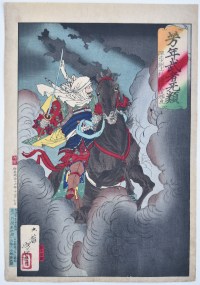
Click here to view image full size.
Uesugi Kenshin Nyudo Terutora. Shows Uesugi no Terutora (aka Kenshin) riding into battle through clouds of smoke against his long-standing adversary Takeda Shingen. From a set of 33 prints Yoshitoshi musha burui, “Yoshitoshi’s Courageous Warriors.” Published by Kobayashi Tetsujiro between 1883 and 1886, this being 1883. A fine design.
Very fine impression of the first edition. (Which should have a three-colour cartouche; two red seals and the publisher’s address in blue in the left margin.) It was reprinted by Tsunajima Kamekichi in 1886 and there are many late printings of the set. Fine colour and condition. Full size with extra paper at left. Signed Taiso Yoshitoshi ga.
Status: Available
Utagawa KUNIYOSHI (1797-1861)
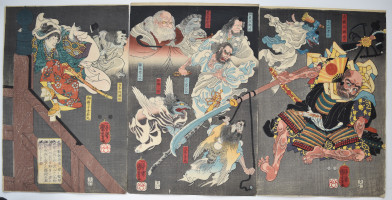
Click here to view image full size.
A triptych showing the famous battle on Gojo Bridge. The story relates how Benkei only needs one more blade to add to the 999 he has wrenched from samurai attempting to cross the bridge in order to fashion an invincible weapon. He meets Ushiwaka Maru (Minamoto no Yoshitsune’s childhood name) and challenges him to a fight on the bridge. Yoshitsune is aided by Sojobo, King of the Tengu (white-bearded in the centre) and other yamabushi tengu. Benkei loses the fight and becomes Yoshitsune’s loyal retainer. Published by Enshuya Hikobei, 1847-50. Robinson T194.
Fine impression, colour and condition. A lovely copy of this triptych. Signed Ichiyusai Kuniyoshi ga.
Status: Available
Mori SOSEN (1747-1821)
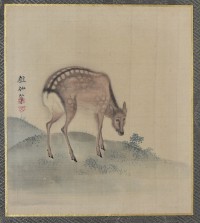
Click here to view image full size.
A fine surimono-sized painting, light colour on silk, 7.75 x 7 in; 19.5 x 17.8 cms. Shows a female sika deer. His life is not well documented but he is known to have studied under the Kano artist Yamamoto Joshunsai (?-1781) before being drawn into Maruyama Okyo’s (1735-1795) artistic circle and his style is more Shijo than anything else. His animal paintings were evidently highly valued by Okyo. He was an immediate favourite with eastern collectors because of his monkey paintings at which he excelled, although he was more versatile than literature implies and highly accomplished at painting other animals. But his images of monkeys take precedence and he is considered the pre-eminent painter, east or west, on this subject. It is alleged that he lived in the woods for three years eating fruit and nuts to study the monkeys and other animals, and is also supposed to have had a cage of monkeys at the back of his house to better observe them.
Very good condition, unmounted. Signed Sosen hitsu with seals So, Sen.
Status: Available
Tsukioka YOSHITOSHI (1839-1892)
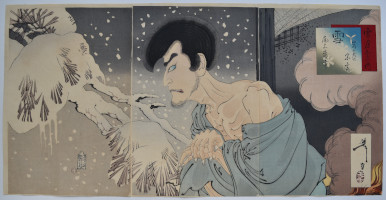
Click here to view image full size.
A triptych showing the priest Iwakura Sogen in a snowy garden. “Snow” from a set of three half-length portraits of actors with title: Setsugekka no uchi, “Snow, Moon, and Flowers.” Sogen was infatuated with the beautiful courtesan Irokotohime. He broke his vow of chastity and was expelled from his temple. Unfortunately, Irokotohime dies and Sogen is left with just his memories. There are other versions of this story and a play with the actor Onoe Baiko V. Published by Akiyama Buemon, 1890.
Fine impression of the first edition with variegated and unaltered sub-cartouche. Fine colour and condition. Signed Yoshitoshi ga.
Status: Available
Tsukioka YOSHITOSHI (1839-1892)
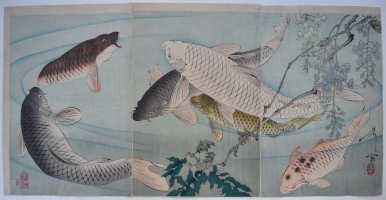
Click here to view image full size.
A triptych showing carp swimming beneath wisteria. A rare and extremely unusual subject in Yoshitoshi’s canon of work. Koi are symbols of love and friendship in Japan. The breeding of ornamental carp began in the 1820s. The outside world was unaware of the advances in breeding colour variations until an annual exposition in Tokyo in 1914. Published by Akiyama Buemon, 1889. There is an original drawing, most likely for this triptych, elsewhere on this site. A much sought after design.
Very fine impression. Fine colour. Completely untrimmed with the extra margins around. Fine condition. Signed Yoshitoshi ga.
Status: Available
Kawamata TSUNEYUKI (1677-c 1744)
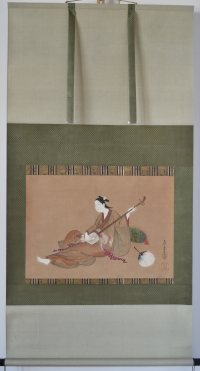
Click here to view image full size.
An original painting, full colour on paper, 13 x 19 in; 33 x 48.3 cms. Shows a reclining beauty playing a shamisen. The subtle outline of her body can be seen through her yukata. A tasseled pillow behind her and a fan lying on the floor. Tsuneyuki was the founder of the Kawamata School. (A pupil was Kawamata Tsunemasa.) Little is known of his life and there are few paintings: A group were in Christies NY, 27/10/1998, lots 40, 42, 44, 45; and there are examples in the BM, reg. no 1931,1116,0.2, the Met, acc. no 36.100.90, and the National Museum of Asian Art, Smithsonian, acc. no. F1898.118. Two small areas of restoration only visible obliquely, otherwise good condition for its period. Presented in double box. Signed Tsuneyuki hitsu with one seal Tsuneyuki, the other unread.
Status: Available
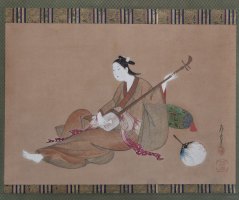
Click here to view image full size.
